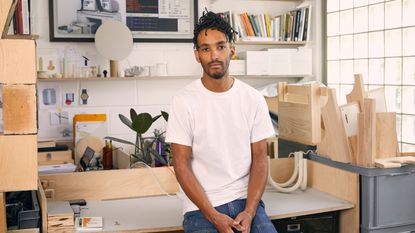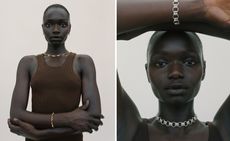Andu Masebo’s stripped-back designs are informed by materials and manufacturing
Wallpaper* Future Icons: designer-to-watch Andu Masebo talks about being inspired by London and the practicalities of making
- (opens in new tab)
- (opens in new tab)
- (opens in new tab)
- Sign up to our newsletter Newsletter

Much of product designer Andu Masebo’s work is a test of limits and an ode to function. With a background in carpentry, ceramics and metalwork, Masebo’s work is informed by a fundamentalist interest in the way objects come to be. ‘I’m interested in making simple things that can be easily accessed. But I also want to reveal the message of something deeper below the surface,’ Masebo explains.
Andu Masebo: London as design inspiration

‘Tubular’ chair, £700, by Andu Masebo, from Atelier 100
Having lived most of his life in London, Masebo’s native city is a distinct and evident influence. ‘It’s the place that has had the biggest impact in shaping my design sensibility,’ he says. This shows itself to be true – from his ‘Candleholder No.12’, an object that originally was designed and manufactured along the south London route of bus number 12, to the recent ‘Tubular Chair’. The ‘Tubular Chair’ is one of 13 pieces offered by the recently launched Atelier100 initiative that seeks to encourage local design and production, with each object having been made within 100km of London.

‘Candleholder No.12’, originally designed and manufactured along the route of the number 12 bus

Work in progress of Candleholder No.12
Masebo studied ceramics at Central Saint Martins and product design at the Royal College of Art. In between both stints, he spent roughly ten years working as a carpenter and metalwork fabricator. These experiences have amalgamated in ‘a practice rooted in the practicalities of making things and the pragmatism required to work within fairly tight constraints’. Working along the lines and thoughts of a sort of design existentialism, Masebo seeks to shorten the cognitive distance between the maker and the users of things. His processes often centre on something essential and irreducible in the way that he works with materials and processes. ‘The design elements to my work are often quite stripped back and centre around a specific machining method or material quality that is relevant to the story contained within the object itself.’

‘Spare Part Side Table’
Bold and decidedly industrial, the ‘Tubular Chair’ uses recycled rubber for its seat, while the frame of the chair is made of stainless steel traditionally used for car exhausts. ‘I had wanted to find a way to work with a car exhaust fabricator long before I designed the chair’, Masebo explains, elaborating on how the chair conforms to the technical constraints of the car exhaust industry. ‘My initial approach was to find a common language and understand the constraints the manufacturers work to. With this information, I was able to come up with an idea that was technically possible to produce. But I also wanted to make something I would not have come up with if I was working on my own.’

Union Chair in Red, produced in conjunction with the Fels ‘Direction of Colour’ exhibition
The philosophy behind this object displays a poignant ability to render function and design within strict limitations. This acuteness is evidently the staple of Masebo’s style, where in the past he has shown himself capable of producing a beautiful and functional chair with just a single plank of wood, and has demonstrated restraint with a shelf series where each piece is only able to fulfil a single, simple function.
andumasebo.com (opens in new tab)
A version of this story appears in January 2023 Wallpaper*, The Future Issue, available now in print, on the Wallpaper* app on Apple iOS, and to subscribers of Apple News +. Subscribe to Wallpaper* today (opens in new tab)

Cup of Tea Shelf
-
 Sapir Bachar’s love for silver makes for abstract jewellery forms
Sapir Bachar’s love for silver makes for abstract jewellery formsSapir Bachar’s fashion background informs her eponymous jewellery brand
By Pei-Ru Keh • Published
-
 Spectacular Wyoming ranch sits within a restored working landscape
Spectacular Wyoming ranch sits within a restored working landscapeThis Wyoming ranch by CLB Architects offers a new approach to the Western architectural tradition, combining daring and functional modern design with a welcoming character
By Jonathan Bell • Published
-
 Last chance to see: Cyprien Gaillard on chaos, reorder and excavating a Paris in flux
Last chance to see: Cyprien Gaillard on chaos, reorder and excavating a Paris in fluxWe interviewed French artist Cyprien Gaillard ahead of his major two-part show, ‘Humpty \ Dumpty’ at Palais de Tokyo and Lafayette Anticipations (until 8 January 2023). Through abandoned clocks, love locks and asbestos, he dissects the human obsession with structural restoration
By Harriet Lloyd-Smith • Published


